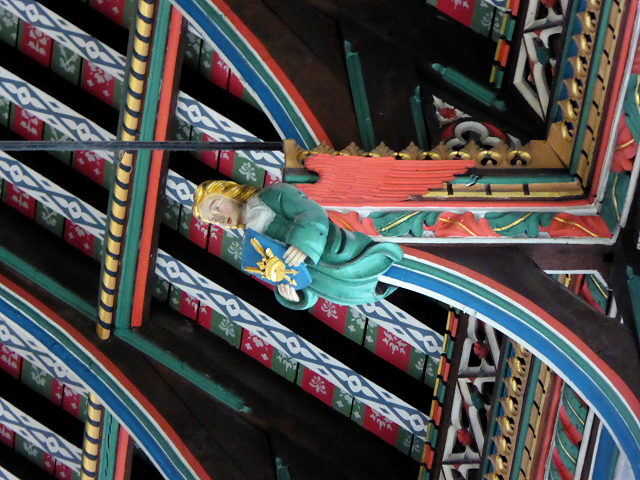Hammerbeam roof
|
The older part of St Edmundsbury Cathedral has a mediaeval hammerbeam roof ornamented with figures of 30 angels. The roof is boldly painted and gilded; the figures on the hammerbeams were painted in 1948, whilst the rest of the roof was coloured in 1982. Decorating the ceiling in this way was used to link the nave with the modern extension. |
Pevsner’s Architectural Glossary (second edition) was published by Yale University Press in 2018. It defines a hammerbeam roof (or hammer-beam roof) as a structure with: ‘horizontal brackets projecting at the wall-plate level like an interrupted tie beam; the inner ends carry hammerposts, which are vertical timbers that support a purlin (or horizontal longitudinal timber) and are braced to a collar-beam above.’
Primarily used as a type of roofing support, a hammerbeam roof permits the support structure to extend beyond the length of the original piece of timber. This method may be more time consuming to construct, but it can be less expensive since it does not require long pieces of timber.
However, a hammerbeam roof is not considered a true truss, since it uses a method that rests one support beam inward and on top of the other. In this sense, it is similar to a corbel.
Tie beams are typically put in place to support this method of construction. The short pieces of timber that project from the wall and serve to anchor the tie beams are sometimes referred to as hammer-beams.
Hammerbeam roofs are often highly decorated. This technique was widely used during the English Gothic architecture period.
[edit] Related articles on Designing Buildings Wiki
Featured articles and news
Government consultations for the summer of 2025
A year of Labour, past and present consultations on the environment, the built environment, training and tax.
CMA competitiveness probe of major housing developers
100 million affordable housing contributions committed with further consultation published.
Homes England supports Greencore Homes
42 new build affordable sustainable homes in Oxfordshire.
Zero carbon social housing: unlocking brownfield potential
Seven ZEDpod strategies for brownfield housing success.
CIOB report; a blueprint for SDGs and the built environment
Pairing the Sustainable Development Goals with projects.
Types, tests, standards and fires relating to external cladding
Brief descriptions with an extensive list of fires for review.
Latest Build UK Building Safety Regime explainer published
Key elements in one short, now updated document.
UKGBC launch the UK Climate Resilience Roadmap
First guidance of its kind on direct climate impacts for the built environment and how it can adapt.
CLC Health, Safety and Wellbeing Strategy 2025
Launched by the Minister for Industry to look at fatalities on site, improving mental health and other issues.
One of the most impressive Victorian architects. Book review.
Common Assessment Standard now with building safety
New CAS update now includes mandatory building safety questions.
RTPI leader to become new CIOB Chief Executive Officer
Dr Victoria Hills MRTPI, FICE to take over after Caroline Gumble’s departure.
Social and affordable housing, a long term plan for delivery
The “Delivering a Decade of Renewal for Social and Affordable Housing” strategy sets out future path.
A change to adoptive architecture
Effects of global weather warming on architectural detailing, material choice and human interaction.
The proposed publicly owned and backed subsidiary of Homes England, to facilitate new homes.
How big is the problem and what can we do to mitigate the effects?
Overheating guidance and tools for building designers
A number of cool guides to help with the heat.
The UK's Modern Industrial Strategy: A 10 year plan
Previous consultation criticism, current key elements and general support with some persisting reservations.
Building Safety Regulator reforms
New roles, new staff and a new fast track service pave the way for a single construction regulator.

























